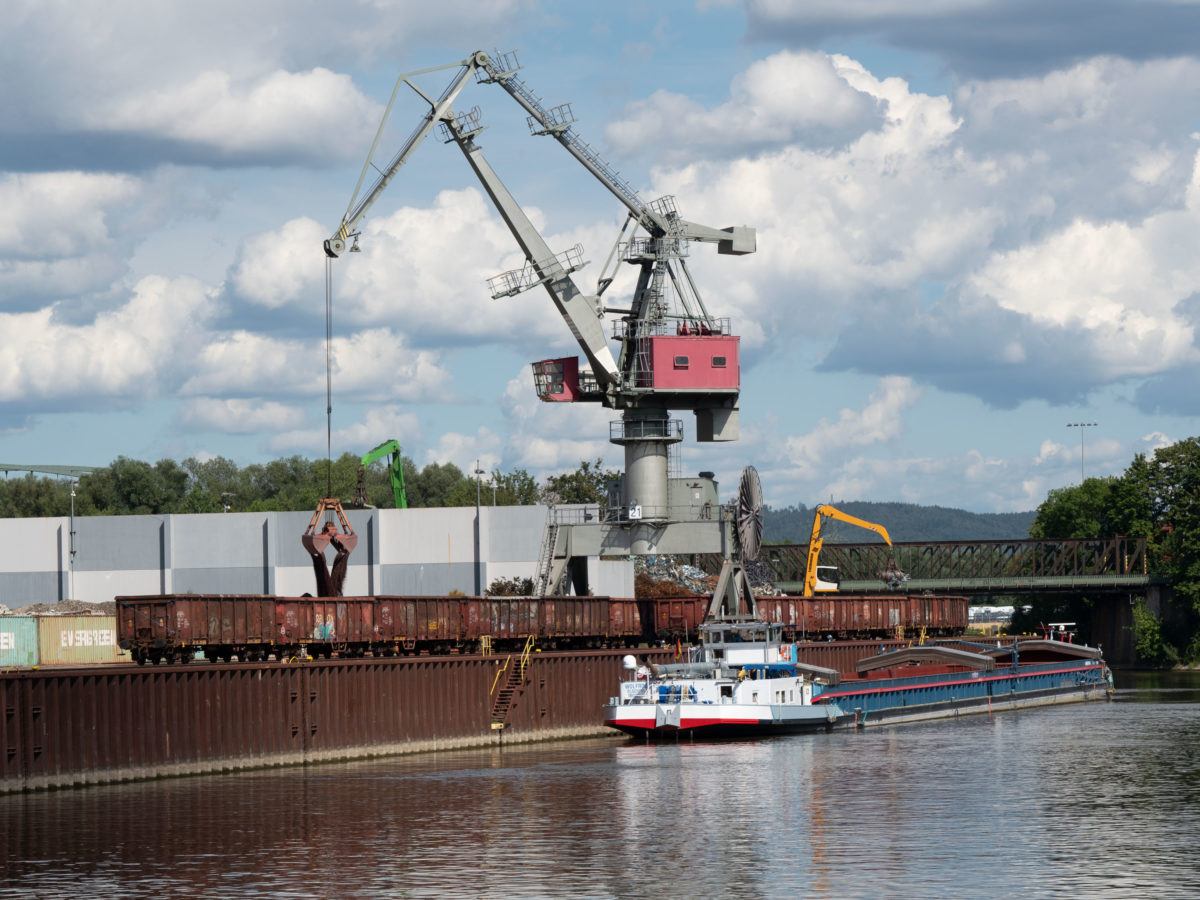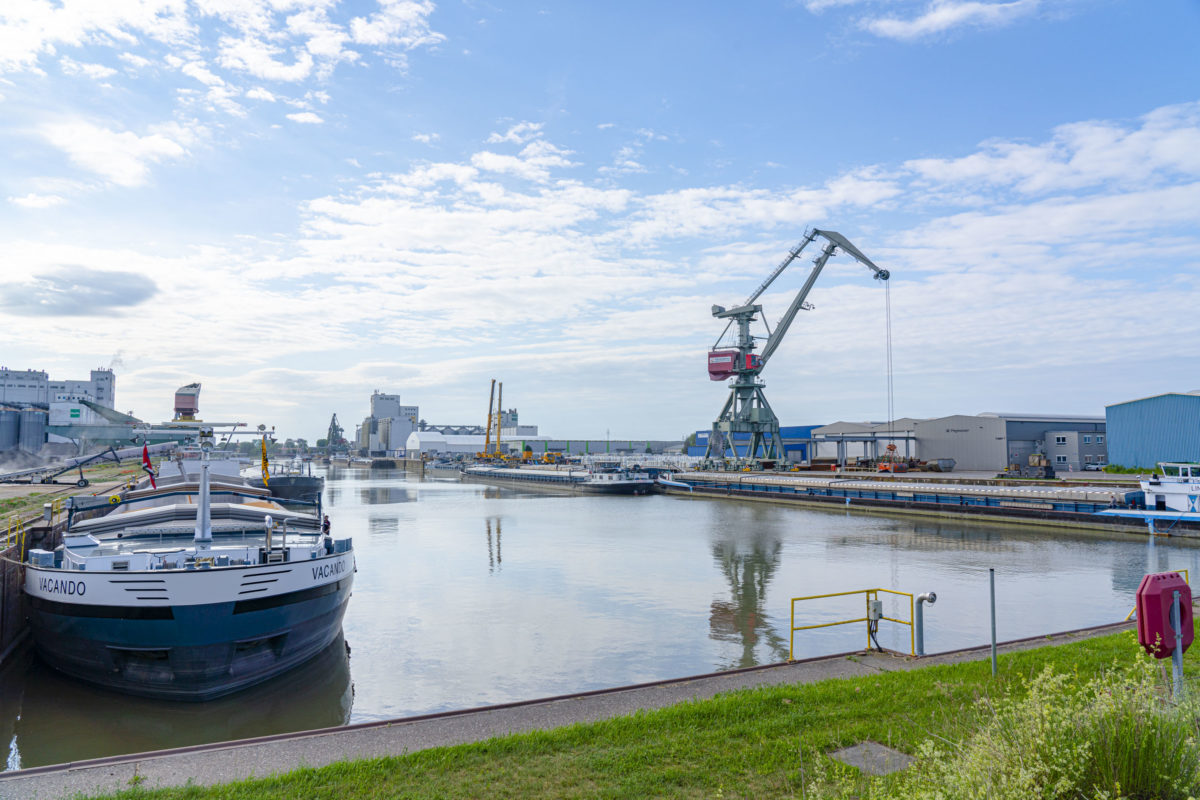12 March 2021 | Regensburg
Stable supply chains and reliable port operations – even in these testing times
bayernhafen Regensburg in the 2020 financial year: 2.92 million tonnes of cargo and freight moved by rail and inland waterway – a 1.8% increase on 2019; bayernhafen invests around € 3.5 million

In bayernhafen Regensburg in the 2020 financial year, 2.92 million tonnes of cargo and freight were moved by rail and inland waterway – a 1.8% increase on the previous year
Regensburg, 12 March 2021 – bayernhafen Regensburg pools the different types of cargo and freight and shifts long-distance transport from the road networks to the environmentally friendly transport modes of inland waterway and rail. Even – and indeed, particularly so – in times of crisis, we must be able to rely on the steady supply of the goods that meet our daily needs and ensure that companies in Bavaria can continue to deliver their products to their customers. In the 2020 financial year bayernhafen Regensburg moved 2.92 million tonnes of goods by inland waterway and rail – a 1.8% increase on the previous year.
Inland waterway handling at bayernhafen Regensburg in 2020 grew by 165,836 tonnes to 1,553,257 tonnes – a 12% increase for the leading port for inland waterway handling in the whole of Bavaria (2019: 1,387,421 tonnes). 1,365,263 tonnes of freight were handled by rail, more than 92% of the volume moved in the previous year (2019: 1,478,105 tonnes). The lion’s share of the shipping tonnage was made up of agricultural products, followed by metal products, ores and construction materials. Additionally, high-value heavy-lift goods, such as transformers, were also loaded onto barge to begin their journeys to markets around the world. Rail freight in 2019 chiefly comprised containers, fuels and construction materials.
Stable supply chains are essential for our society – this has become particularly apparent in such testing times as these.
Stefan Ring, Head of Technology and Operations at bayernhafen Regensburg
“Stable supply chains are essential for our society,” says Stefan Ring, the Head of Technology and Operations at bayernhafen Regensburg. “This has become particularly apparent in such testing times as these. Reliable port operations have made an important contribution to achieving and maintaining this stability.” The companies operating from bayernhafen Regensburg ensure that the supply chains delivering the groceries and other goods that meet our daily needs work reliably and efficiently.
At bayernhafen Regensburg in March, Horst Pöppel Spedition commenced operations at its new multi-user warehouse, with dedicated sidings to handle food/non-food products, such as wine arriving by rail from Italy. These goods are then sent from Regensburg to the distribution centres serving the retail food industry. Another example is the supply of heating oil to households and fuels for petrol stations – in 2020, these were also distributed via the VARO fuel depot in bayernhafen Regensburg. And Cemex cement transported to Regensburg by rail is distributed to construction sites by Mossandl from its interim storage depot at bayernhafen.
bayernhafen Regensburg, along with Aschaffenburg, Bamberg, Nuremberg and Roth, and Passau, is one of the six bayernhafen locations. Even in times of crisis, its skill in developing interfaces enables bayernhafen to continue to pursue its goal of furthering the modal shift, because the ability of the bayernhafen locations to efficiently link the different transport modes enables businesses to use rail and inland waterway for long-distance transport as alternatives to transport by road. Through this strategy, bayernhafen is making a key contribution to tapping the full potential of the different transport modes. This takes pressure off the road networks and reduces CO2 emissions.
In 2020, combined transport handling at bayernhafen Regensburg amounted to 82,110 TEU (twenty-foot equivalent unit), more than 81% of the volume handled in 2019. In addition to transporting containers to and from the North Sea ports, rail is used to transport swap bodies and semi-trailers from and to Hannover/Osnabrück.
Continued investment in port infrastructure
In 2020, bayernhafen once again maintained the high level of investment it had made over the previous years, spending around € 3.5 million on the redevelopment of bayernhafen Regensburg’s commercial sites and port infrastructure.
Although our core business naturally involves developing and managing industrial sites, commercial areas and transport facilities, they can be combined quite nicely with natural areas.
Andrea Betz,
Head of Real Estate Business at bayernhafen Regensburg
Boost for biodiversity through eco-account
bayernhafen is planning to establish an eco-account to cover further structural development at bayernhafen Regensburg: at a dedicated site of around 16 ha located between Äußere Wiener Straße and the southern bank of the Danube. This will enable bayernhafen Regensburg to implement the requisite biodiversity offsetting measures in advance and maintain a reserve for future use. The plan is to carry out renaturation measures for suitable areas – for example by transforming land previously used for agriculture into alluvial woodland and extensive grassland areas. In future planning permission procedures, eco-account sites can be re-purposed as biodiversity offsetting and ecological compensation areas.
“In our capacity as ‘site architect’ we create the conditions for providing high-intensity logistics companies with commercial sites in close proximity to rail and inland waterway facilities,” says Andrea Betz, Head of Real Estate Business at bayernhafen Regensburg. “Protecting biodiversity is also one of our key priorities. Although our core business naturally involves developing and managing industrial sites, commercial areas and transport facilities, they can be combined quite nicely with natural areas. Our planned eco-account site in Regensburg is a good example of this.”
bayernhafen manages its land strategically, focusing on recycling, rather than consuming, land. This combination of land and infrastructure makes bayernhafen Regensburg a strong anchor point and a major hub for the exchange of goods for the East Bavarian economy. The key prerequisite for this is the clear demarcation between port and residential areas to ensure good neighbourhood relations. The ongoing zoning plan procedures for the west port / oil port involve achieving legal certainty and planning reliability out of a historical cluster of conflicting interests – for the benefit of both the customers of the port and for its neighbours.
In 2020, inland waterway handling at bayernhafen Regensburg grew by 165,836 tonnes to 1,553,257 tonnes – a 12% increase for the leading port for inland waterway handling in the whole of Bavaria. 1,365,263 tonnes of freight were moved by rail, more than 92% of the volume of the previous year.

